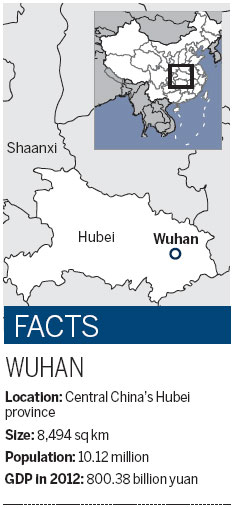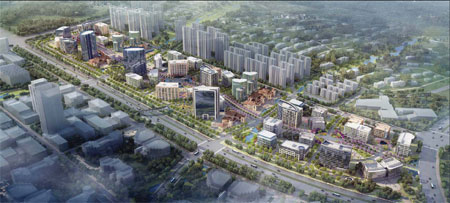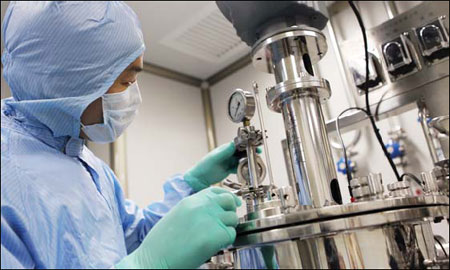Central connection renewed
Updated: 2013-09-06 09:30
By Lyu Chang, Zhou Lihua and Todo Balazovic (China Daily)
|
|||||||||||
Wuhan is pulling out all the stops to generate a flow of high-tech ideas
Far from China's financially bustling coast, at a crossroads along the country's largest river, one historic city is calling for innovation to flow.
Wuhan, capital of Central China's Hubei province, is pushing for big ideas as city planners put the polish on the newly transformed Wuhan East Lake High-Tech Development Zone.
Designed to attract top creative minds locally and internationally, the city on the Yangtze has revamped one of the nation's crucial electronics producing regions in the hope of creating a hub of innovation.
Like the national economy, local officials want to move the city away from its traditional manufacturing roots to become a generator of ideas.
"Innovation is the key for future growth," says Xia Yamin, deputy director of the administrative committee for the development zone.
"We should go beyond being a manufacturing base and become a magnet for economic development and innovation."

Referred to by some as the Chicago of China for its reputation as an industrial transportation hub, the city of 10 million people is using its status as a key gateway connecting western China to the east to cash in on the stream of ideas passing through the city.
So far the transformation from transportation to high technology has proved fruitful, with local planning officials estimating Wuhan's economy growing at about 12.5 percent annually. Gross domestic product is expected to double in the next five years.
One of the biggest driving forces is the Wuhan high-tech development zone, which generates more than 500 billion yuan ($81.7 billion, 62 billion euros) a year in revenue, accounting for more than half of Wuhan's GDP.
Other industries such as petroleum, engineering, food processing, alternative energy, environmental protection and services outsourcing, are also forging ahead.
While for many outside of China, Wuhan may be more identifiable from its global debut in Kung Fu Panda 2, the city has helped connect millions to the Internet as one of the biggest producers of fiber optics globally.
A key component in computer networking and connecting to high-speed Internet, fiber optics was first produced in Wuhan more than 20 years ago. It is estimated its factories produce more than 55 percent of fiber optic cable in China and 25 percent globally.
Hoping to cash in on the momentum created by producing what is now one of the most used pieces of modern technology, the city hopes to redefine itself as a fulcrum for technological breakthroughs.
Already the annual output of the city's electronic information sector is projected to rise to 380 billion yuan in 2015 from 114 billion yuan in 2010, according to figures from the city government.
Attracting companies with a series of preferential policies, such as three years of free office rental space and one-year interest-free loans, Wuhan seeks to draw in large and small software, technology, research and development companies.
For those with a reputation for creating original, innovative businesses, Wuhan authorities are willing to offer up to $15.8 million (12 million euros) to set up shop in the city.
So far, city officials say nearly 6,000 foreign enterprises have established operations in the city, and about 100 of the world's top 500 companies have invested in 124 projects there.
The bigger names include US home security systems producer Honeywell and German pharmaceutical giant Bayer AG.
Intertwined with the city's efforts at becoming a technological focal point for Central China, the local government established Software New City, a short drive away from the technology zone.
It's a core startup project of the Wuhan East Lake High-Tech Development Zone, aiming to create Silicon Valley-type high-tech industrial clusters of innovation.
The city actually called in experts from Silicon Valley in California to help work on the aesthetic and logistical aspects of the development zone.
Companies such as Oracle Corp, the third-largest software company in the US behind Microsoft and IBM, have already expressed interest.
Shao Hui, general manager of Wuhan Software City Development Co, says that more than 1,000 world-class enterprises will set up their Chinese operations and offices in the software park.
There, they will pursue software development and IT services, research and development, as well as explore cloud computing.
With a total investment of more than 10 billion yuan and an area of more than 3 square kilometers, the park will provide hundreds of thousands of jobs after construction is completed at the end of the year.
It is estimated that its annual output value will surpass 50 billion yuan.
The idea, however, is not to rely on foreign companies for revenue, rather it is to create an environment where ideas can be shared.
"We are not simply moving software companies from the US here," Xia says. "Instead, we are trying to learn from their management and business models to create the largest and most international base of software and information services in Central China."
So far, the high-tech development zone has established 13 technology business startup parks, 11 industrial technology alliances and more than a dozen technical centers and other service agencies to help new companies get off the ground. At Chinese startup Hongtuo New Technology Co in the Wuhan East Lake High-Tech Development Zone, a senior engineer showed off the company's products: lasers that can be widely used in the medical, new energy and new material industries.
Founded in 2009, the company has about 40 employees and has seen strong growth in the high-tech market with key clients such as Bayer and Huawei Technologies Co Ltd, the world's second-largest telecoms network equipment maker.
Li Derong, a senior engineer at Hongtuo, says starting from scratch, the company got huge support from the Wuhan East Lake development zone.
"When we moved to the zone, we were given an entire floor, with space of 1,000 square meters as our operating office," he says. "It is free for the first three years."
Li says the park helped the company a lot, offering something more than just a startup deal. Rather, it has an eye on long-term development for investors.
Xia says the idea is not just to attract companies but also to help them stay.
"Providing low initial costs is only the beginning. Once a company settles here, we are paying more attention to their operating costs," he says.
In addition to financial incentives, the development zone is poised to tap into Wuhan's vast supply of brainpower.
Renowned nationally for its education in the fields of engineering and technology, Wuhan is home to about 80 universities and 1.2 million students.
Offering further career opportunities to students, Wuhan has more than 100 high-tech research institutions with 80,000 researchers and technicians. It also has 20 national laboratories and 20 national R&D centers.
A total of 59 academics from the Chinese Academy of Sciences and the Chinese Academy of Engineering, the nation's most prestigious network for scientists and engineers, work at the universities and institutions in Wuhan.
It was the city's academic credentials that caught the eye of Zhou Pengfei, chief executive officer of Wuhan YZY Biopharma Co Ltd, a biotech company working on new ways to deliver oncology treatment.
"The main reason we came here is the educational environment. The city has a great talent pool," says Zhou, a Stanford University graduate who worked with a major pharmaceutical company in the US before returning to China.
Zhou and his team of scientists are working on creating customized cancer treatment kits by working with hospitals to collect information on patients.
He says being close to some of the sharpest minds in pharmaceutical R&D has provided ample opportunities for breakthroughs.
"With so many scientists in the area, it's been a big advantage. We are often talking with fellow scientists about research and problems we are facing," Zhou says.
"You never know when someone may know something or has researched something you need. It can save a lot of time and money."
So far, business is going well, he says, and deals with several Chinese hospitals are in the works.
Wuhan highlights the government's determination to support the rise of Central China. Last month, President Xi Jinping paid a visit to the city, further underscoring government support for industrial relocation from coastal areas to inland regions.
Much of the nation's development in the past decade has focused on coastal regions such as Guangzhou, Shenzhen and Shanghai, where easy access to shipping ports have made them vital gateways of commerce.
Now, with several of China's newly built high-speed rail networks converging in Wuhan, its mayor Tang Liangzhi envisions the city as a major metropolis in Central China.
The main point in promoting the rise of the "Central China policy" is developing urbanization in the middle reaches of the Yangtze River. Essential to that is supporting Wuhan in its drive to become a national center for technology, he says.
Lu Jinyong, a professor at the University of International Business and Economics in Beijing, says it is evident that Wuhan's education and technological strengths, together with its transit hub status, will play an important role in the nation's development.
However, while providing job opportunities for fresh graduates can create a spike in the number of skilled workers in the city, retaining an innovative workforce can be difficult, he says.
High demand for skilled workers, competitive salaries and the desire to advance their careers make China's young workforce one of the most transient. If the city wants to truly become a long-term hub for bright young minds, developers must also focus on lifestyle, Lu says.
"The challenge also lies in building a nice living environment, as well as high incomes, to meet the demand of specialists and scientists, so that it can keep them here," he says.
Contact the writers through lvchang@chinadaily.com.cn
|
An artist's rendering of Wuhan Software New City Technology Innovation Zone. Provided to China Daily |
|
An employee works at a laboratory in YZY Biopharma Co Ltd in Wuhan, Hubei province. The city offers high-quality human resources and a strong R&D capacity to companies. Guan Xin / China Daily |
( China Daily European Weekly 09/06/2013 page18)
Today's Top News
List of approved GM food clarified
ID checks for express deliveries in Guangdong
Govt to expand elderly care
University asks freshmen to sign suicide disclaimer
Tibet gears up for new climbing season
Media asked to promote Sino-Indian ties
Shots fired at Washington Navy Yard
Minimum growth rate set at 7%
Hot Topics
Lunar probe , China growth forecasts, Emission rules get tougher, China seen through 'colored lens', International board,
Editor's Picks

|

|

|

|

|

|







